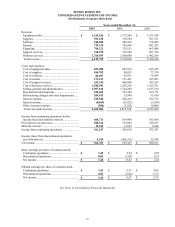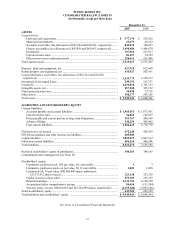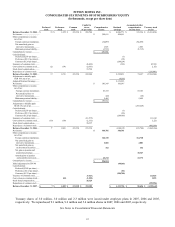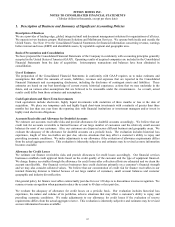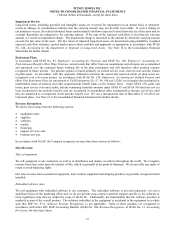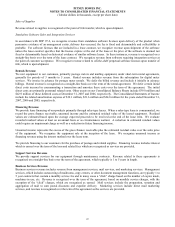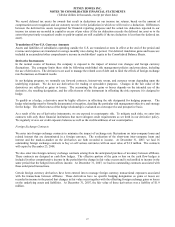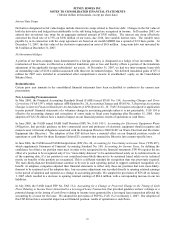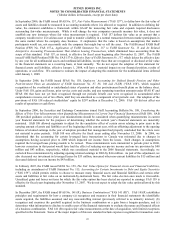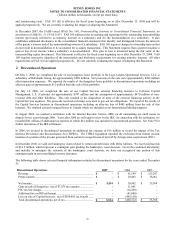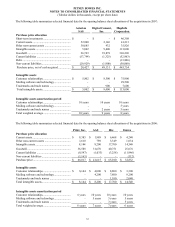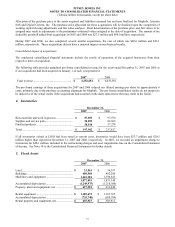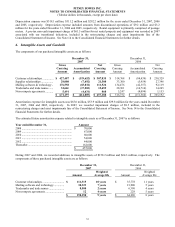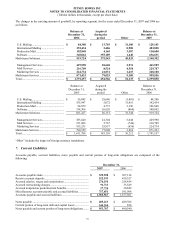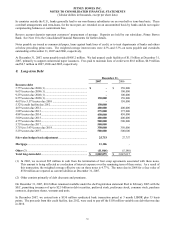Pitney Bowes 2007 Annual Report Download - page 65
Download and view the complete annual report
Please find page 65 of the 2007 Pitney Bowes annual report below. You can navigate through the pages in the report by either clicking on the pages listed below, or by using the keyword search tool below to find specific information within the annual report.PITNEY BOWES INC.
NOTES TO CONSOLIDATED FINANCIAL STATEMENTS
(Tabular dollars in thousands, except per share data)
47
We record deferred tax assets for awards that result in deductions on our income tax returns, based on the amount of
compensation cost recognized and our statutory tax rate in the jurisdiction in which we will receive a deduction. Differences
between the deferred tax assets recognized for financial reporting purposes and the actual tax deduction reported in our
income tax return are recorded in capital in excess of par value (if the tax deduction exceeds the deferred tax asset or to the
extent that previously recognized credits to paid-in-capital are still available if the tax deduction is less than the deferred tax
asset).
Translation of Non-U.S. Currency Amounts
Assets and liabilities of subsidiaries operating outside the U.S. are translated at rates in effect at the end of the period and
revenue and expenses are translated at average monthly rates during the period. Net deferred translation gains and losses are
included in accumulated other comprehensive income in stockholders’ equity in the Consolidated Balance Sheets.
Derivative Instruments
In the normal course of business, the company is exposed to the impact of interest rate changes and foreign currency
fluctuations. The company limits these risks by following established risk management policies and procedures, including
the use of derivatives. The derivatives are used to manage the related cost of debt and to limit the effects of foreign exchange
rate fluctuations on financial results.
In our hedging program, we normally use forward contracts, interest-rate swaps, and currency swaps depending upon the
underlying exposure. We do not use derivatives for trading or speculative purposes. Changes in the fair value of the
derivatives are reflected as gains or losses. The accounting for the gains or losses depends on the intended use of the
derivative, the resulting designation, and the effectiveness of the instrument in offsetting the risk exposure it is designed to
hedge.
To qualify as a hedge, a derivative must be highly effective in offsetting the risk designated for hedging purposes. The
hedge relationship must be formally documented at inception, detailing the particular risk management objective and strategy
for the hedge. The effectiveness of the hedge relationship is evaluated on a retrospective and prospective basis.
As a result of the use of derivative instruments, we are exposed to counterparty risk. To mitigate such risks, we enter into
contracts with only those financial institutions that meet stringent credit requirements as set forth in our derivative policy.
We regularly review our credit exposure balances as well as the creditworthiness of our counterparties.
Foreign Exchange Contracts
We enter into foreign exchange contracts to minimize the impact of exchange rate fluctuations on inter-company loans and
related interest that are denominated in a foreign currency. The revaluation of the short-term inter-company loans and
interest and the mark-to-market on the derivatives are both recorded to income. At December 31, 2007, we had 16
outstanding foreign exchange contracts to buy or sell various currencies with an asset value of $1.9 million. The contracts
will expire by December 23, 2008.
We also enter into foreign currency exchange contracts arising from the anticipated purchase of inventory between affiliates.
These contracts are designed as cash flow hedges. The effective portion of the gain or loss on the cash flow hedges is
included in other comprehensive income in the period that the change in fair value occurs and is reclassified to income in the
same period that the hedged item affects income. At December 31, 2007, we had no outstanding contracts associated with
these anticipated transactions.
Certain foreign currency derivatives have been entered into to manage foreign currency transactional exposures associated
with the transactions between affiliates. These derivatives have no specific hedging designation so gains or losses are
recorded in income in the period that changes in fair value occur together with the offsetting foreign exchange gains or losses
on the underlying assets and liabilities. At December 31, 2007, the fair value of these derivatives was a liability of $1.9
million.



